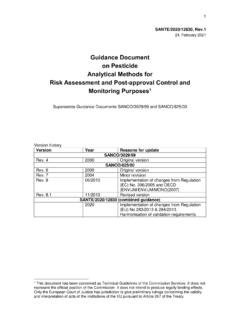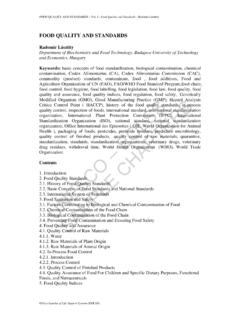Transcription of CODEX GENERAL STANDARD FOR CONTAMINANTS AND …
1 1 CODEX STANDARD 193-1995. CODEX GENERAL STANDARD FOR CONTAMINANTS AND TOXINS. IN FOOD AND FEED. CODEX STAN 193-1995. 1. PREAMBLE. SCOPE. This STANDARD contains the main principles which are recommended by the CODEX Alimentarius in dealing with CONTAMINANTS and toxins in food and feed, and lists the maximum levels and associated sampling plans of CONTAMINANTS and natural toxicants in food and feed which are recommended by the CAC to be applied to commodities moving in international trade. This STANDARD includes only maximum levels of CONTAMINANTS and natural toxicants in feed in cases where the contaminant in feed can be transferred to food of animal origin and can be relevant for public health.
2 DEFINITION OF TERMS. GENERAL The definitions for the purpose of the CODEX Alimentarius, as mentioned in the Procedural Manual, are applicable to the GENERAL STANDARD for CONTAMINANTS and Toxins in Food and Feed (GSCTFF) and only the most important ones are repeated here. Some new definitions are introduced, where this seems warranted to obtain optimal clarity. When reference is made to foods, this also applies to animal feed, in those cases where this is appropriate. contaminant CODEX Alimentarius defines a contaminant as follows: "Any substance not intentionally added to food, which is present in such food as a result of the production (including operations carried out in crop husbandry, animal husbandry and veterinary medicine), manufacture, processing, preparation, treatment, packing, packaging, transport or holding of such food or as a result of environmental contamination.
3 The term does not include insect fragments, rodent hairs and other extraneous matter". This STANDARD applies to any substance that meets the terms of the CODEX definition for a contaminant , including CONTAMINANTS in feed for food-producing animals, except: 1) CONTAMINANTS having only food and feed quality significance ( copper), but no public health significance, in the food(s) given that the standards elaborated within the CODEX Committee on CONTAMINANTS in Foods (CCCF) has the objective to protect public health. 2) pesticide residues , as defined by the CODEX definition that are within the terms of reference of the CODEX Committee on pesticide residues (CCPR).
4 3) residues of veterinary drugs, as defined by the CODEX definition, that are within the terms of reference of the CODEX Committee on residues of Veterinary Drugs in Foods (CCRVDF). 4) Microbial toxins, such as botulinum toxin and staphylococcus enterotoxin, and microorganisms that are within the terms of reference of the CODEX Committee on Food Hygiene (CCFH). 5) residues of processing aids that are within the terms of reference of the CODEX Committee on Food Additives (CCFA) 1 . Natural toxins included in this STANDARD The CODEX definition of a contaminant implicitly includes naturally occurring toxicants including toxic metabolites of certain microfungi that are not intentionally added to food and feed (mycotoxins).
5 Toxins that are produced by algae and that may be accumulated in edible aquatic organisms such as shellfish (phycotoxins) are also included in this STANDARD . Mycotoxins and phycotoxins are both subclasses of CONTAMINANTS . 1. Processing aids are any substance or material, not including apparatus or utensils, and not consumed as a food ingredient by itself, intentionally used in the processing of raw materials, foods or its ingredients, to fulfil a certain technological purpose during treatment or processing and which may result in the non-intentional but unavoidable presence of residues or derivatives in the final product.
6 Adopted 1995; Revised 1997, 2006, 2008, 2009; Amended 2009, 2010. 2 CODEX STANDARD 193-1995. Endogenous natural toxicants, such as solanine in potatoes, that are implicit constituents of food and feed resulting from a genus, species or strain ordinarily producing hazardous levels of a toxic metabolite(s), phytotoxins are not generally considered within the scope of this STANDARD . They are, however, within the terms of reference of the CCCF. and will be dealt with on a case by case basis. Maximum level and related terms 2. The CODEX maximum level (ML) for a contaminant in a food or feed commodity is the maximum concentration of that substance recommended by the CODEX Alimentarius Commission (CAC) to be legally permitted in that commodity.
7 PRINCIPLES REGARDING CONTAMINANTS IN FOOD AND FEED. GENERAL Contamination of food and feed may pose a risk to human (and/or animal health). Moreover in some cases they may also have a negative impact on the quality of the food or feed. Food and feed can become contaminated by various causes and processes. contaminant levels in food and feed shall be as low as reasonably achievable through best practice such as Good Agricultural Practice (GAP) and Good Manufacturing Practice (GMP) following an appropriate risk assessment. The following actions may serve to prevent or to reduce contamination of feed and food 3 : - preventing food and feed contamination at the source, by reducing environmental pollution.
8 - applying appropriate technology control measure(s) in food and feed production, manufacture, processing, preparation, treatment, packing, packaging, transport or holding. - applying measures aimed at decontamination of contaminated feed or food and measures to prevent contaminated feed or food to be marketed for consumption. To ensure that adequate action is taken to reduce contamination of food and feed a Code of Practice shall be elaborated comprising source related measures and Good Manufacturing Practice as well as Good Agricultural Practice in relation to the specific contamination problem.
9 The degree of contamination of food and feed and the effect of actions to reduce contamination shall be assessed by monitoring, survey programs and more specialized research programs, where necessary. When there are indications that health hazards may be involved with consumption of food that is contaminated, it is necessary that a risk assessment should be undertaken. When health concerns can be substantiated, a risk management measure must be applied, based on a thorough evaluation of the situation and consideration of a range of risk management options. Depending on the assessment of the problems and the possible solutions, it may be necessary to establish MLs or other measures to control the contamination of food and feed.
10 In special cases, specific advice on dietary recommendations may also have to be considered to complement other regulatory measures, when the measures are not sufficiently adequate to protect public health and safety. National measures regarding food and feed contamination should avoid the creation of unnecessary barriers to international trade in food and feed commodities. The purpose of the GSCTFF is to provide guidance about possible approaches to eliminate or reduce the contamination problem and to promote international harmonization through recommendations which in turn may prevent trade barriers and disputes.















